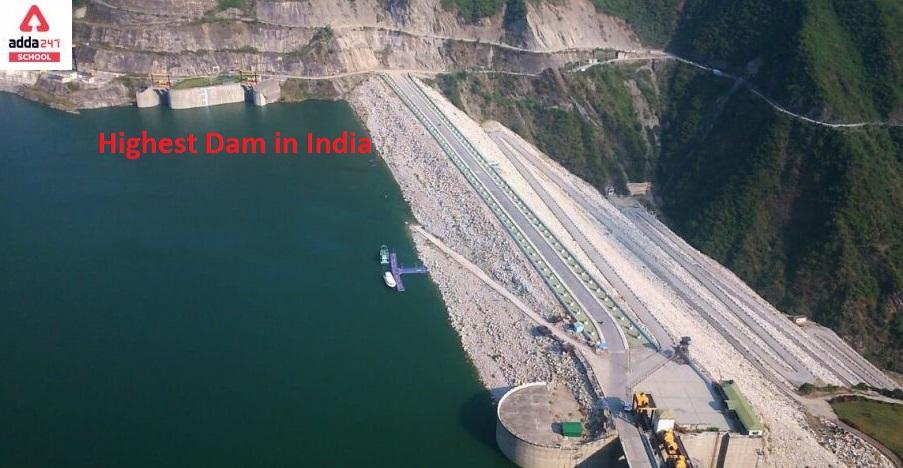Table of Contents
Highest Dam in India is located in which state?
A dam acts like a barrier that stops the flow of water, which makes a water reservoir. The water reservoir is used to generate electricity. The electricity produced by this process is called hydroelectricity. The reservoir is not only used for generating electricity, but it is also used for irrigation and aquaculture, and it also suppresses the formation of floods. The dam is designed in such a way that it preserves water and also uses the proper method to execute the controlled release of water.
Highest dam in India- Height, River and State
The Tehri Dam is the highest in India, it is about 260.5 meters high and 592 meters long. The Tehri dam and hydropower plant are used for hydroelectricity generation and irrigation purposes. Tehri dam is across the Bhagirathi River in Uttarakhand, India.
The construction of the Tehri dam began in 1978, but the investigation and design were completed in 1961 and 1972 respectively. The delay in the construction of the dam was caused due to financial and economic impacts. The construction of the Tehri dam was under the supervision of the irrigation department of Uttar Pradesh. Later in 1988, Tehri Hydro Development Corporation was formed to manage the dam. The funds were divided into two, 75% was provided by the federal government and 25% from the state.
Tehri Dam is about 855 ft and its length is 1,886 ft, the width of the dam is 66 ft, and the width of the base is 3,701 ft. The reservoir created by the dam is about 3,200,000 acre-ft or 4.0 cubic kilometers. The hydro capacity installed in the dam is 1000 MW, with 1000MV of storage hydroelectricity pump.
Both the Tehri dam and Tehri pumped-storage hydroelectricity power plant are part of the Tehri Hydropower Complex. The total expenditure of this project under the Tehri Hydropower Complex was 1 billion USD. Power generated from the reservoir is distributed all around northern India. It includes the states like Jammu and Kashmir, Himachal Pradesh, Uttrakhand, Uttar Pradesh, Punjab, Delhi, Haryana, Rajasthan, and Chandigarh.
With every good project, there are a lot of objections against it. Similarly, when Tehri Dam was founded, a person named Virendra Dutt Saklani formed the Anti-Tehri Dam struggle committee. From the 1980s to 2004 this committee was led by environmental activist Sunderlal Bahuguna. The main reason for the protest was the displacement of the inhabitants of the place where the dam was being built and the environmental cause like deforestation and pollution of water.

How electricity is produced in Dams?
Dams are generally used for electricity generation and other water-related purposes like irrigation, flood management, water management, etc. The dams block the flow of water and make a reservoir, this reservoir helps in generating electricity. At the bottom of the reservoir, a turbine propeller is installed. The water pressure which passes through the spinning turbine generates power. The power generated from the turbine is used to generate electricity.
Types of Dams
There are many types of dams found in India. Based on the structure the dams are of the following types
- Gravity Dam- Gravity Dams are dams constructed with concrete and stone masonry. The mechanism is very simple, the dams are designed in such a way that it holds back water by using the weight of the material only. It is designed in such a way that every section of the dam is independent of the other section.
- Arch Dams – it is a concrete dam that is curved upstream. The arch Dams are designed in such a way that the force of water or hydraulic pressure, presses against the arch which straightens the arch and gives strength to the structure. For narrow canyons or Gorges with steep walls, arch Dams help to support the structure and are most suitable for that type of water body.
- Arch-Gravity Dams – It is made from both the characteristics of arch and gravity dams. The dam is curved upstream which directs the water pressure against the walls of the canyons.
- Embankment Dams- It is large artificial dams. A semi-plastic mound of many compositions of soil, sand, and clay is used to create artificial dams. It is waterproof.
- Earth-fill Dams- These are constructed similar to embankment Dams but with well-compacted earth. It is called earthen dams or rolled earth dams or earth dams.
List of Major Dams in India
We have listed a few of India’s most significant dams here. The table below contains a complete list of India’s major dams.
| Name of Dam | State Name | River Name |
| Nizam Sagar Dam | Telangana | Manjira River |
| Somasila Dam | Andhra Pradesh | Pennar River |
| Srisailam Dam | Andhra Pradesh | Krishna River |
| Singur dam | Telangana | Manjira River |
| Ukai Dam | Gujarat | Tapti River |
| Dharoi Dam | Gujarat | Sabarmati River |
| Kadana dam | Gujarat | Mahi River |
| Dantiwada Dam | Gujarat | Banas River |
| Pandoh Dam | Himachal Pradesh | Beas River |
| Bhakra Nangal Dam | Himachal Pradesh and Punjab Border | Sutlej River |
| Nathpa Jhakri Dam | Himachal Pradesh | Satluj River |
| Chamera Dam | Himachal Pradesh | Ravi River |
| Baglihar Dam | Jammu and Kashmir | Chenab River |
| Dumkhar Hydroelectric Dam | Jammu and Kashmir | Indus River |
| Uri Hydroelectric Dam | Jammu and Kashmir | Jhelum River |
| Maithon Dam | Jharkhand | Barakar River |
| Chandil Dam | Jharkhand | Swarnarekha River |
| Panchet Dam | Jharkhand | Damodar River |
| Tunga Bhadra Dam | Karnataka | Tungabhadra River |
| Linganamakki dam | Karnataka | Sharavathi River |
| Kadra Dam | Karnataka | Kalinadi River |
| Alamatti Dam | Karnataka | Krishna River |
| Supa Dam | Karnataka | Kalinadi or Kali river |
| Krishna Raja Sagara Dam | Karnataka | Kaveri River |
| Harangi Dam | Karnataka | Harangi River |
| Narayanpur Dam | Karnataka | Krishna River |
| Kodasalli Dam | Karnataka | Kali River |
| Malampuzha Dam | Kerala | Malampuzha River |
| Peechi Dam | Kerala | Manali River |
| Idukki Dam | Kerala | Periyar River |
| Kundala Dam | Kerala | Kundala Lake |
| Parambikulam Dam | Kerala | Parambikulam River |
| Walayar Dam | Kerala | Walayar River |
| Mullaperiyar Dam | Kerala | Periyar River |
| Neyyar Dam | Kerala | Neyyar River |
| Rajghat Dam | Uttar Pradesh and Madhya Pradesh Border | Betwa River |
| Barna Dam | Madhya Pradesh | Barna River |
| Bargi Dam | Madhya Pradesh | Narmada River |
| Bansagar Dam | Madhya Pradesh | Sone River |
| Gandhi Sagar Dam | Madhya Pradesh | Chambal River |
| Yeldari Dam | Maharashtra | Purna river |
| Ujani Dam | Maharashtra | Bhima River |
| Pawna Dam | Maharashtra | Maval River |
| Mulshi Dam | Maharashtra | Mula River |
| Koyna Dam | Maharashtra | Koyna River |
| Jayakwadi Dam | Maharashtra | Godavari River |
| Bhatsa Dam | Maharashtra | Bhatsa river |
| Wilson Dam | Maharashtra | Pravara River |
| Tansa Dam | Maharashtra | Tansa river |
| Panshet Dam | Maharashtra | Ambi River |
| Mula Dam | Maharashtra | Mula river |
| Kolkewadi Dam | Maharashtra | Vashishti River |
| Girna Dam | Maharashtra | Girana river |
| Vaitarna Dam | Maharashtra | Vaitarna river |
| Radhanagari Dam | Telangana | Bhogawati River |
| Lower Manair Dam | Telangana | Manair River |
| Mid Manair Dam | Telangana | Manair River and SRSP Flood Flow Canal |
| Upper Manair Dam | Telangana | Manair River and Kudlair River |
| Khadakwasla Dam | Maharashtra | Mutha River |
| Gangapur Dam | Maharashtra | Godavari river |
| Jalaput Dam | Andhra Pradesh and Odisha Border | Machkund River |
| Indravati Dam | Odisha | Indravati River |
| Hirakud Dam | Odisha | Mahanadi River |
| Vaigai Dam | Tamil Nadu | Vaigai River |
| Perunchani Dam | Tamil Nadu | Paralayar River |
| Mettur Dam | Tamil Nadu | Kaveri River |
| Govind Ballabh Pant Sagar Dam / Rihand dam | Uttar Pradesh | Rihand River |
| Tehri Dam | Uttarakhand | Bhagirathi River |
| Dhauli Ganga Dam | Uttarakhand | Dhauli Ganga River |
Related Articles:
- Which Is The Longest Dam In India In 2022?
- How Many States And Capitals Of India 2022
- Aufbau Principle Definition, Formula, Example, Limitation
- Area Of Sphere- Formula In Maths
- BODMAS Full Form With Sign, Examples In Computer
- Rank Of The Matrix – Definition, Formulas, Examples
- SSC Full Form- What Is Staff Selection Commission?
- CBSE Class 10 English Important Questions For Term 2
- Learn Table Of 7 – Multiplication Table Of 7 – 7 Times Table
- Electrochemical Series Of Metals- Ncert Trick, Table
Highest Dam in India: FAQs
- What is the tallest dam in the world?
A. The tallest dam in the world is Nurek Dam in Tajikistan which is 300m.
2. Which is the longest dam in India?
A. Hirakud dam is the longest dam in India. It is about 25.8 km long and is located across the Mahanadi River, located in Odisha.
3. Which is the largest dam in India?
A. Bhakra Nangal Dam is the largest dam in India which is about 225 meters high. It is the second-largest dam in Asia. It is situated across the Sutlej River in Himachal Pradesh and Punjab.
4. Which is the oldest Dam in India?
A. Kallanai Dam is the oldest Dam in India, which is located in Tamil Nadu. It was built between 100 BC to 100 AC. It is situated across the Kaveri River.
5. What is the dam?
A. A dam acts like a barrier that stops the flow of water, which makes it a water reservoir. The water reservoir is used to generate electricity


 SOF Olympiad Exam Date 2024-25 Out, Chec...
SOF Olympiad Exam Date 2024-25 Out, Chec...
 NEET Revised Answer Key 2024 Out, Downlo...
NEET Revised Answer Key 2024 Out, Downlo...
 Karnataka PGCET Admit Card 2024 Out, Dow...
Karnataka PGCET Admit Card 2024 Out, Dow...












